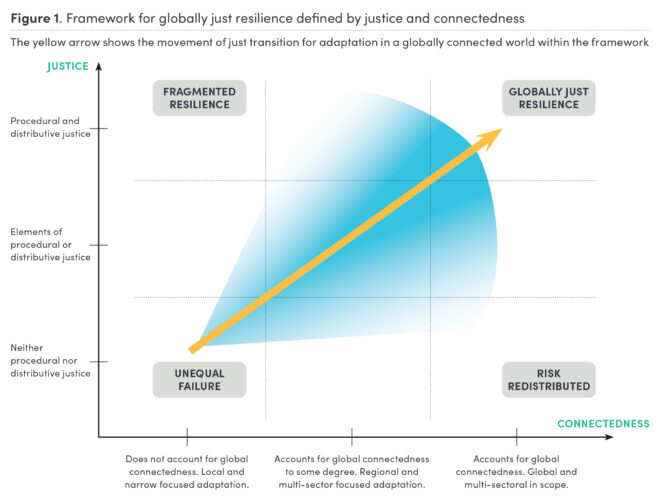A Just Transition for Climate Change Adaptation: Towards Just Resilience and Security in a Globalising World

Introduction
Justice has long been a central element of the international community’s approach to climate change, including with regard to financial support for adaptation in developing countries. Yet, even as it has become increasingly clear that climate risks – and adaptation measures – often extend across national borders, a new challenge has emerged: how to ensure globally just resilience.
This policy brief aims to expand our collective view of justice in adaptation by considering the globally interconnected nature of our economies and societies.
Building on the literature on just transitions for climate change mitigation, it presents a novel framework for a just transition for adaptation, with the objective of achieving globally just resilience. The full brief provides two case studies demonstrating the utility of the framework for analysing and advancing globally just resilience: (1) Agricultural trade and just transitions in the Brazilian coffee supply chain and (2) Just transition for adaptation in the Blue Nile Basin.
*The key messages from the brief are provided below. Download the full brief from the right-hand column.
Key messages
- In a globalising world, the impacts of both climate change and adaptation measures are increasingly likely to be felt well beyond the places where they occur – even thousands of kilometres away.
- Ensuring that adaptation is truly just and equitable requires recognising transboundary climate risk and building resilience on a global scale. This involves avoiding actions that simply shift risks to other actors or reinforce existing vulnerabilities.
- We propose a framework for a just transition for climate change adaptation, focused on two dimensions: justice – procedural and distributional – and connectedness. Achieving globally just resilience requires addressing both dimensions together, but neither is all-or-nothing: incremental steps can make adaptation more globally just over time.
- A just transition for adaptation is crucial to ensuring both human well-being and countries’ security, as resource scarcity and other stresses caused by climate change or by maladaptation can exacerbate conflict and even indirectly fuel violence.
- Going forward, we recommend that policymakers strengthen multilateral cooperation for globally just resilience; develop agreed principles to move from ambition to action; craft incentives to invest in just transitions for adaptation; and advance research to support decision-making.
A novel framework for globally just resilience
A new analytical framework is required to better account for the transboundary effects of climate change and conceptualise a just transition for adaptation in this context. Our proposed framework, illustrated in the figure below (extracted from the brief, p.2), includes two core dimensions:
- Justice, broadly conceptualised;
- Connectedness, referring to the scope and connectivity of a system being adapted.
Each exists across a spectrum, and each can advance without the other. Only by addressing both together, however, can we achieve globally just resilience.

Procedural justice refers to the degree to which those affected by climate risk and adaptation are recognised and able to fully participate in decision-making processes.
Distributive justice refers to how the benefits and harms of adaptation outcomes are allocated. It engages with questions such as “who benefits, and how?” and “who gets left behind?”
On the other axis, connectedness captures the degree to which adaptation actions account for the broader systems and structures beyond the place or sector in which they occur.
Truly understanding the effects of an adaptation action thus requires considering how it may affect people in other places – be it via ecosystems, value chains, human migration or financial flows. As with justice, connectedness can be addressed at different levels: from accounting for local context but failing to recognise systemic and structural factors, to making some connections across regions or sectors, to fully recognising global and multisectoral causes and effects.
Implications for human security
Failing to sufficiently account for justice in adaptation may appear to be in wealthier nations and communities’ self-interest, but it can create significant human security risks.
The adverse effects of climate change can exacerbate the grievances of already vulnerable communities and open the door to more significant security challenges. Reduced water availability, food scarcity and land degradation due to climate change may lead to increased poverty and hunger, especially in agricultural communities in developing countries. That, in turn, can escalate tensions, particularly in the absence of good governance. Terror and organised crime groups with regional and even global reach can benefit from increased human insecurity.
Adopting a just approach to adaptation is thus necessary to both safeguard human security and limit the subsequent negative effects on traditional national security and geopolitics.
Achieving globally just resilience: The road ahead
The aim of this brief has been to make the case for a just transition for adaptation. In order to take this work forward, it is necessary to move from awareness to action. Specifically, we recommend:
Strengthen multilateral cooperation for globally just resilience
Climate diplomacy for adaptation should be substantially strengthened, moving beyond discussions of finance provision to meaningfully incorporate equity and human security, and to include actors across sectors and scales which have not traditionally been involved in adaptation, but are central to international cooperation. This includes, but is not limited to, the Global Goal on Adaptation under the Paris Agreement.
Develop agreed principles to move from ambition to action
One helpful way to move from ambition to action is to develop shared principles, so actors have a common understanding of how this issue should be addressed, to facilitate policy-making. The “seven principles for a just transition [for mitigation]” developed by Atteridge and Strambo in 2020 may serve as a useful starting point, here adjusted for use in the context of just adaptation:
- Actively encourage adaptation;
- Avoid the creation of adaptation “losers” or redistributing climate risk;
- Provide international support for vulnerable regions and communities;
- Support people and communities who are negatively affected by adaptation measures;
- Reduce climate risk and distribute the burdens of adaptation fairly, ensuring that risk is not transferred from the private to the public sector;
- Address existing global inequalities, including the distribution of climate risk;
- Ensure that a planning process is both inclusive and transparent.
Craft incentives to invest in just transitions for adaptation
Another key task for policy will be to carefully craft incentives to invest in just transitions for adaptation. Options for this may range from direct regulation and new multilateral agreements, to providing tax incentives or developing mutually beneficial investment frameworks with international partners.
Advance research to support decision-making
More research is required to support decision-making. This includes, but is not limited to, work that accurately describes current exposure to and transmission of transboundary climate risk, identifies concrete policy options to manage such risk, and assesses the trade-offs associated with different policy options for different communities and actors with justice in mind.
- Climate-resilient trade and production: the transboundary effects of climate change and their implications for EU member states
- Meeting the global challenge of adaptation by addressing transboundary climate risk
- Climate adaptation must be reframed from a local issue to a global responsibility
- The Geopolitics of Food Security: Barriers to the Sustainable Development Goal of Zero Hunger
- International spillovers in SDG implementation: the case of soy from Argentina
- The Adaptation without Borders Index of exposure to indirect impacts of climate change

Comments
There is no contentYou must be logged in to reply.